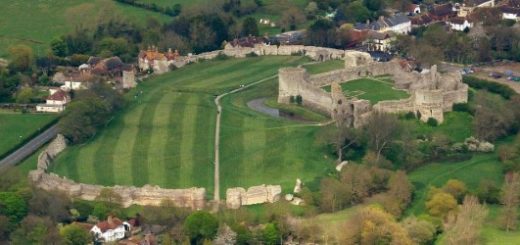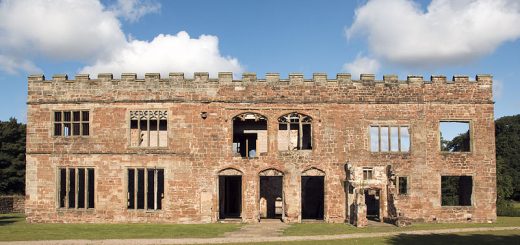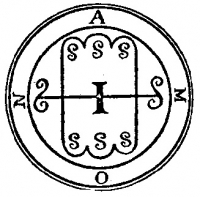The Hellfire Club
“Hellfire Club” is a name that brings in mind a coven of hooded and caped Enlightment-era gentlemen practising all kinds of debauchery, Satan worship being the most prominent. Over the years stories have abounded about Sir Francis Dashwood and his “monks” practising all kinds of wickedness in their “abbey” by the Thames: mock Christian rituals, Black Masses, cursing ceremonies.. As far as I know the only thing they still haven’t been accused of is sacrificing children to Satan and devouring their bodies. In the following article I’ll try to outline the known facts about Sir Francis and his “monks”.
The Devil and The Age of Reason
It has often been assumed that the “monks” of Medmenham called themselves “Hellfire Club” and that they were the first to call themselves by this name. This assumption is wrong on both counts. The original club to bear this title was founded in London in 1719 by the infamous but charismatic Philip Wharton (1698-1731), 1st Duke of Wharton and a few friends.
Wharton’s exploits are almost legendary: he accumulated enormous debts, squandered whole fortunes, sold back his title to King George I, wrote the famous “Persian Letter”, and fought valiantly for the Jacobites in Spain remaining all the while incredibly popular and influential. Alexander Pope called him “the scorn and wonder of our days”.
The purpose of this club was to enliven the “dull traditional Sunday” with drinks and rude songs. According to a contemporary satire “Religion is their scorn, foul vice their Pride, The Clergy is their Subject to deride”. It is generally assumed that during these rakes’ meeting parodies of religious rites were carried out, though these were probably more akin to Blackadder’s and Melchett’s drinking nights than to the generally imagined Satanic ritual.
The club was closed by Royal edict in 1721; among the motivations was how the club’s members did “corrupt the minds and morals of one another”. It must be understood that XVIII century England was awash in these “gentlemen’s clubs”, a lesser known by-product of the Age of Reason: Hell, the Devil and eternal damnation were seen as “barbarous relics” of the Dark Ages and Sunday was now to be dedicated to more earthly pursuits. Drinking claret, singing rude songs, talking about horses and hounds and having a good laugh were by far the favorite activities of these gentlemen.
What is now known as “Hellfire Club” was founded in 1746 by that remarkable character, Sir Francis Dashwood (1708-1781). It was officially known as “The Knights of St Francis” or, more informally, as the “Medmenham Monks”: “Hellfire Club” was a name bestowed upon it by critics of Sir Francis and his followers. “Hellfire” Francis was a remarkable character in a remarkable era: he was an MP for over 20 years, he held various important offices (Treasurer to King George III, Postmaster General etc), he was widely believed to be a Jacobite secret agent and a Rosicrucian. He traveled widely during his youth and many believe that his dislike of Catholicism led him to found a mock monastic order.
Sir Francis had a great passion for what we may now call theme clubs: previously he had founded two, the Dilettanti and the Divan Club. The Dilettanti was a club for men that had visited Rome: they dressed in togas and discussed Roman literature and antiquities. As such it has survived until recently. The Divan Club admitted only men who had visited the Othoman Empire: they wore in Turkish garb and met for dinner according to various pseudo-Oriental observances. He was also a member of the Spalding Gentlemen’s Society (a prestigious learned society whose members included many Freemasons) and the Mount Haemus Grove (a neo-druidic order believed to have been founded at Oxford in 1245), whose members claimed connection with the so-called Mysteries of Ceridwen of Snowdonia.
The Knights of St Francis were founded and originally met in the “George & Vulture” public house in London, though earlier meetings among founding members may have taken place in Sir Francis’ London home, located in Hanover Square. The “Knights” originally met in a reserved room dominated by a great “Rosicrucian” lamp Sir Francis had purchased for the purpose: this lamp was later presented to the West Wycombe church. The club having proven a great success, it was decided to move it to more suitable premises. Accordingly in 1750 Sir Francis leased Medmenham Abbey a few miles from his ancestral home at West Wycombe.
Medmenham was built for the Cistercian Order in the XIII century but was shut down by Henry VIII during the Dissolution of Monasteries (1536-1539), being sold to the Duffield family a little later. The Duffields were only interested in the lands and left the monastery to deteriorate. In 1595 they built a new house nearby, using stones and bricks taken from the abbey. By 1750 the house was very dilapidated and the abbey itself little more than a ruin.
Sir Francis set about the task of rebuilding Medmenham with the help of Nicholas Revett in the mixture of Gothic and Neoclassical styles then fashionable (see for example Strawberry Hill, Horace Walpole’s mansion). The building was completely revamped and a cloister and a tower added. Most of the frescoes were painted by Giuseppe Mattia Borgnis, who had already worked on Sir Francis’ West Wycombe manor.
The motto carved over the doorway “Fay �e que voudras”- “do what thou wilt”- has always been interpreted by malicious souls as an invitation to unrestrained excesses but really comes from Rabelais’ Gargantua, Sir Francis being well-read in French literature. Rabelais used it as the motto of his imaginary abbey of Thelema by the Loire where monks, instead of the customary vows of poverty, celibate and obedience were all wealthy, married and free to pursue whatever activities they wished. This is probably a reference to the “vows” of the Medmenham “monks”.
What the monks were pursuing can be gauged by the contents of the abbey itself: the chapter room contained a bookcase, whose contents ranged from love novels to religious literature, and was well furnished with backgammon tables, musical instruments and decks of cards. The abbey was well supplied with fine wines, claret and port being particular favorite of the English aristocracy which made up the bulk of the Medmenham “monks” but from the documents left it would appear that booze consumption was not out of the ordinary.
 A little after taking possession of the Abbey works on the celebrated “Hellfire Caves” were begun. In one of his many eccentric acts Sir Francis hired many more men than really needed from surrounding communities, paying them one shilling a day. His biographers claim he took this measure to alleviate sufferings on the local communities resulting from poor harvests. The caves were originally a natural formation and Sir Francis had them enlarged to the present size by 1754. It has been claimed that a “pagan altar” was built in the caves during Celtic or Roman times (no archaeological evidence has been found to date) and that any attempt to build the St Lawrence Church near the present entry to the caves were thwarted by an “unseen” force which demolished at night what was done by day until a local priest heard a “disembodied voice” telling him to build the church at the present location where it would not be disturbed. And so it was.
A little after taking possession of the Abbey works on the celebrated “Hellfire Caves” were begun. In one of his many eccentric acts Sir Francis hired many more men than really needed from surrounding communities, paying them one shilling a day. His biographers claim he took this measure to alleviate sufferings on the local communities resulting from poor harvests. The caves were originally a natural formation and Sir Francis had them enlarged to the present size by 1754. It has been claimed that a “pagan altar” was built in the caves during Celtic or Roman times (no archaeological evidence has been found to date) and that any attempt to build the St Lawrence Church near the present entry to the caves were thwarted by an “unseen” force which demolished at night what was done by day until a local priest heard a “disembodied voice” telling him to build the church at the present location where it would not be disturbed. And so it was.
A common claim is that wild orgies went on inside the Inner Sanctum or that each monk had his own private room to entertain “visitors”. However first-hand witnesses say otherwise. Horace Walpole, who dined at least once at Medmenham as a guest, said “each has his cell, in which is indeed little more than a bed” and that near the chapel there were a few cells filled “…with cots where the brothers take their women” (whatever Walpole meant by cot, at the time used to indicate a either a camp bed or a navy hammock, is not clear) , while John Wilkes, a confirmed member, brushed away rumours of sinister activities by stating “No profane eye dared to penetrate the English Eleusinian Mysteries of the Chapter Room where the Monks assembled on solemn occasions […] secret rites performed and libations to the Bona Dea”. It would appear that while the “brothers” often took their mistresses and courtesans to Medmenham (such visits are called “private devotions” in the Abbey registers) no wild orgy ever went on in the Inner Sanctum. Privacy was probably much more valued than promiscuity and it would appear that the “monks” had some unwritten rule of conduct to which they all complied.
 Hell on Earth?
Hell on Earth?
In 1751 Sir Francis decided to have the St Lawrence Church restored: as many writers pointed out “an unlikely act for a Satanist”. Apparently the main source of inspiration for the restoration was the Sol Invictus temple in Palmyra, recently rediscovered, and the whole church was now seen as a homage to Christ as “Light of the World”, down to the large golden globe on the church spire. Despite the large sum spent many people didn’t like the church’s new looks: many felt it too “heathen” or even likened it to “an Egyptian hall”, probably a reference to Freemasonic Lodges.
So what were the Medmenham Monks up to? What were their beliefs? It’s hard to tell but, despite allegations to the contrary, Black Masses and Satan Worship definitely weren’t practised at Medmenham. Rumours about the “brothers” got increasingly wilder over the years, culminating in 1979 with Martin Ebon’s allegations about paedophilia being the main activity of the “monks”. It’s very difficult to trust many XVIII century sources, let alone the most recent ones. But from what we have been able to patch together it would appear that two different kinds of persons were part of the Knights. The first and most numerous were simply interested in drinking, singing bawdy songs, playing a game of backgammon while talking about horses or popular literature and meeting in privacy with their mistresses. The second, which included Sir Francis himself and others like the celebrated poet Paul Whitehead, were probably genuinely interested in the revival of some ancient “pagan” cults.
Dashwood’s interest in the ancient religions is well documented and many clues point in that direction: the Mount Haemus Grove has always been reputed the most “serious” of the neo-druidic orders, a whole wing of his West Wycombe mansion had been turned into a temple to Dionysus (who is not the same thing as Bacchus) and his involvement in the Dilettanti proves he was capable of serious research. If so what was their object of veneration?
As we have already seen Wilkes gave it away when he talked about the Bona Dea, one of the many names by which The Goddess, now so famous thanks the Wiccans, was known in Roman times before Isis worship became so widespread. Gardner himself wrote a lengthy essay about the caves’ structure being a homage to The Goddess herself. He was probably wrong on this account but there’s little doubt about who was Sir Francis’ most beloved deity. More statues of Venus/Aphrodites than any other subject pepper Medmenham and Sir Francis had at least one painting of himself in religious attire worshiping Venus; Robert Graves and the other proponents of the “White Goddess” theory were still two centuries away but it was already known that before the Aryan invaders brought their masculine sky gods, a feminine, motherly goddess was the most worshipped deity in Europe, her cult being so widespread that the invaders could not wipe it out and had to simply take it over.
Lucianus of Samosata often boasted how infinitely superior was The Goddess to the pathetic Olympic deities with their petty squabbles and earthly preoccupations. Does this make Sir Francis and his Knights pagans? It must be understood that being “pagan” was deemed very fashionable among XVIII century gentlemen and learned persons. Even one of the greatest writers of the century, Wolfgang Goethe, often called himself “an old pagan” and his good mate, Friedrich Schiller, even went a step further by calling Christianity “the great swindle that contaminated the whole world”. So it’s not a wonder to suggest that, beside more earthly pursuit like drinking and amorous encounters, Sir Francis Dashwood attempted bringing back some kind of ancient cult. Maybe it all started out as a joke, as a mockery of a Catholic religious order, and then grew in scope. Maybe I am getting it all wrong. We’ll never know.
by M.C.
























The Hellfire caves, West wycombe.
http://www.paranormalinvestigationsltd.com Just wanted to point out that the top picture of the Hellfire peice is of the main entrance to the hellfire caves at west wycombe not medmenham abbey.
Thanks I was there when it was taken. I hadn’t realised that a title and an incorrect one at that had been attached to it. Thanks for the correction
I was there when it was taken. I hadn’t realised that a title and an incorrect one at that had been attached to it. Thanks for the correction
Of course it is